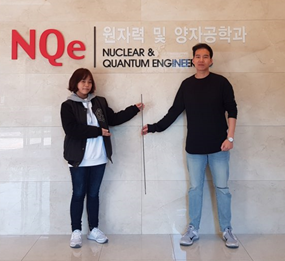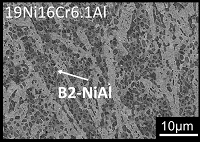2018-12-10




A research team led by Hyunmyung Kim (Ph.D student) and Prof. Changheui Jang (Nuclear and High Temperature Materials Lab, at the Dept. of Nuclear and Quantum Engineering) of KAIST has developed high strength alumina-forming duplex stainless steels (ADSS) as accident tolerant fuel (ATF) cladding materials, which are anticipated to substantially improve safety of nuclear power plants. In addition, the research team succeeded in fabrication of prototypic thin tube of 1.6 m long, achieving a major milestone for fuel cladding application. (Fig. 1)
It is well known that Fukushima accident in 2011 was escalated due to the explosion of hydrogen generated from the dramatic high-temperature oxidation of zirconium (Zr) alloy cladding. Since then, the development of ATF cladding materials with superior corrosion/oxidation resistance has been actively carried out in the countries with nuclear power plant (NPP) to replace the current Zr alloy cladding materials. A series of attempts have been made to apply coatings on Zr alloy cladding with oxidation resistance materials and to develop new materials based on SiC or ferritic stainless steels. Each of these approach made some progresses, yet is facing difficulties in demonstration and fabrication of more than 4 m long thin cladding tube.
On the other hand, the developed ADSS alloys can 1) be readily fabricated by commercial production procedure, 2) improve corrosion resistance during normal operation as well as high-temperature oxidation resistance during Fukushima-like severe accident conditions, thereby fundamentally eliminate hydrogen generation, and 3) achieve very high strength (about 1 GPa) benefited from a homogeneous duplex microstructure with fine precipitates (Fig. 2). Also, it has been shown that the effects on nuclear fuel and core design by ADSS alloys are minimal. Recently, upto 1.6 m long ADSS prototype tubes with 0.3 mm thickness have been successfully manufactured following the commercial fuel cladding production procedure (Fig. 3), which confirmed the excellent manufacturability required for commercial application of ADSS alloys as ATF claddings.
The results of this research were published in the Journal of Nuclear Materials (August 2018), one of the best journal of nuclear materials, and further progresses were also presented at related international conferences such as NuMat2018 and NURER2018. In addition, two related domestic (Korean) patents on claims for the compositions and microstructure have been registered, and two international patents are now pending in the US and China.
The ADSS alloys were developed by the support of the KUSTAR-KAIST international collaborative research and the Engineering Research Center (ERC) Program of MSIT of Rep. of Korea. The fuel cladding tube manufacturing was jointly conducted with KEPCO Nuclear Fuel Co. as an Energy Technology Development Program of KETEP/MOTIE of Rep. of Korea.

<Fig. 1. Students (Hyunmyung Kim and Chaewon Kim) holding a prototype ADSS fuel cladding (0.3 mm x 8 mm x 910 mm) recently fabricated>


<Fig 2. Microstructure of ADSS alloys showing duplex with fine precipitates (right image) and tensile properties showing very high strength with good ductility (left image)>

<Fig. 3. Photo of 1.6 m long prototype ADSS fuel cladding tube (0.3 mm x 8 mm x 1600 mm)>